
Miranda Blake
Výzvy a řešení v moderním řízení dopravy
Vytvořeno: 16.12.2024
•
Aktualizováno: 16.12.2024
Moderní řízení dopravy je strategický přístup k plánování, organizaci a řízení účinného a efektivního pohybu zboží a materiálu z místa původu do místa určení. Zahrnuje využití technologií a poznatků založených na datech k optimalizaci přepravních procesů, snížení nákladů a zvýšení spokojenosti zákazníků.
V tomto blogu se zabýváme hlavními problémy a řešeními, které s tím souvisejí.
Klíčové výzvy
Jedním z nejpalčivějších problémů, které musí vozové parky řešit, je řízení výdajů na pohonné hmoty. Ty tvoří významnou část provozních výdajů a jejich nestálost může způsobit chaos v rozpočtových procesech a celkové ziskovosti. Nepředvídatelnost cen pohonných hmot vytváří vlnový efekt v celém dodavatelském řetězci a nutí společnosti přijímat obtížná rozhodnutí o absorpci nákladů nebo zvýšení cen, což může mít dopad na jejich konkurenceschopnost. Prozíravé podniky však přijímají strategie, jak související rizika zmírnit:
● Uzavření smluv o zajištění paliv, které umožní uzamknout ceny na určité období, a tím stabilizovat výdaje.
● Investice do moderních, úsporných vozidel, aby se snížila spotřeba a celkové náklady.
● zkoumání alternativních zdrojů paliv, jako je bionafta nebo stlačený zemní plyn, které by sloužily jako rezerva proti výkyvům cen tradičních paliv.
Jedno z řešení - SNAP Fuel - umožňuje bezproblémovou správu paliva:
● Provozovatelé vozového parku mají přístup k podrobným zprávám o výdajích, které poskytují transparentnost nákladů a pomáhají jim identifikovat trendy a oblasti, které je třeba zlepšit.
● Díky partnerství se společností Certas Energy mohou uživatelé využívat zvýhodněné sazby za palivo, což dále snižuje výdaje.
Dopravní zácpy
Dalším problémem je doprava. S rostoucím počtem obyvatel měst se zvyšuje zatížení stávající infrastruktury, což vede k problémům v celém logistickém řetězci. Zpoždění se stávají běžným jevem, spotřeba paliva prudce roste a provozní náklady stoupají, zatímco spokojenost zákazníků klesá kvůli prodlouženým dodacím lhůtám.
Existuje několik taktik, jak těmto negativním dopadům čelit:
● Využití pokročilého softwaru optimalizace trasy může pomoci určit nejefektivnější trasy, a tím snížit čas jízdy a spotřebu paliva.
● Integrace dopravních dat v reálném čase do provozu může umožnit dynamické úpravy trasy na základě aktuálních podmínek.
● Vypracování na míru šitých plánů městské logistiky může podnikům umožnit zvládnout problémy specifické pro dané město, jako jsou zóny s omezeným přístupem a dopravní špičky.
Narušení dodavatelského řetězce
Další problém, se kterým se potýkají vozové parky, je narušení provozu - od přírodních katastrof přes geopolitické události až po nedostatek pracovních sil -, což vede ke zpožděním, zvýšeným nákladům a snížení úrovně služeb, což zpochybňuje odolnost systémů řízení dopravy.
Organizace mohou pro řešení těchto přerušení přijmout několik strategií:
● Diverzifikace: Získávání materiálů a služeb od více dodavatelů může snížit závislost na jednom dodavateli a zmírnit rizika.
● Ohodnocení rizik: Pravidelné provádění těchto hodnocení může pomoci identifikovat zranitelná místa v dodavatelském řetězci a podpořit nouzové plánování.
● Monitorování v reálném čase: Zavedení technologií, které poskytují přehled o dodavatelském řetězci v reálném čase, může zvýšit rychlost reakce a urychlit rozhodování.

Inovativní řešení
S dalším vývojem a integrací technologií se slibuje, že přetvoří budoucnost řízení dopravy, vyřeší dlouhodobé problémy a otevře nové možnosti růstu a inovací.
● Telematika: Systémy sledování vozidel poskytují údaje o poloze, optimalizaci trasy a chování řidiče v reálném čase, což usnadňuje informovanější rozhodování.
● Zařízení IoT: mohou monitorovat stav vozidla, spotřebu paliva a podmínky nákladu a zajistit tak optimální výkon a bezpečnost.
● AI a strojové učení: Díky nim můžete využít prediktivní analýzu a předpovídání poptávky, což zlepšuje optimalizaci tras a řízení zásob.
● Blockchain: Zavedení této technologie může zlepšit transparentnost, bezpečnost a sledovatelnost dodavatelského řetězce a posílit důvěru mezi zúčastněnými stranami.
Udržení a školení řidičů
Nedostatek řidičů je dalším problémem řízení dopravy, který se ministerstvo dopravy snaží vyřešit zahájením konzultace o způsobech jeho řešení. Vyzvali jsme řidiče kamionů, aby se k návrhu vyjádřili na facebookové stránce SNAP. Zatímco mnozí se k tomuto programu nevyjádřili, 72,5 % z nich zpochybnilo termín "nedostatek řidičů" a označilo ho za strašení. Místo toho uvedli několik důvodů, proč zkušení řidiči kamionů opouštějí odvětví.
Proto je stále velmi důležité přilákat a udržet si kvalifikované řidiče. Vláda zavedla několik opatření, ale správci vozových parků a řidiči nákladních vozidel mohou podniknout kroky sami:
● Konkurenční odměny a benefity: Nabídka atraktivních balíčků může na konkurenčním trhu práce pomoci přilákat největší talenty.
● Flexibilní pracovní podmínky: Jejich poskytování může zvýšit spokojenost s prací a snížit míru fluktuace.
● Pokročilé školení a rozvoj dovedností: Investice do průběžných programů může řidiče vybavit schopnostmi potřebnými k tomu, aby vynikli ve svých funkcích a přizpůsobili se novým technologiím.
Dalším klíčovým způsobem, jak si udržet řidiče, je co nejvíce jim usnadnit práci - a to se týká i placení za parkování a mytí. Naštěstí je tu SNAP.
Získejte podporu od SNAP
Chcete-li se dozvědět více o našich službách a o tom, jak mohou pomoci při řízení dopravy, kontaktujte nás na čísle +44 (0)1603 777242.



